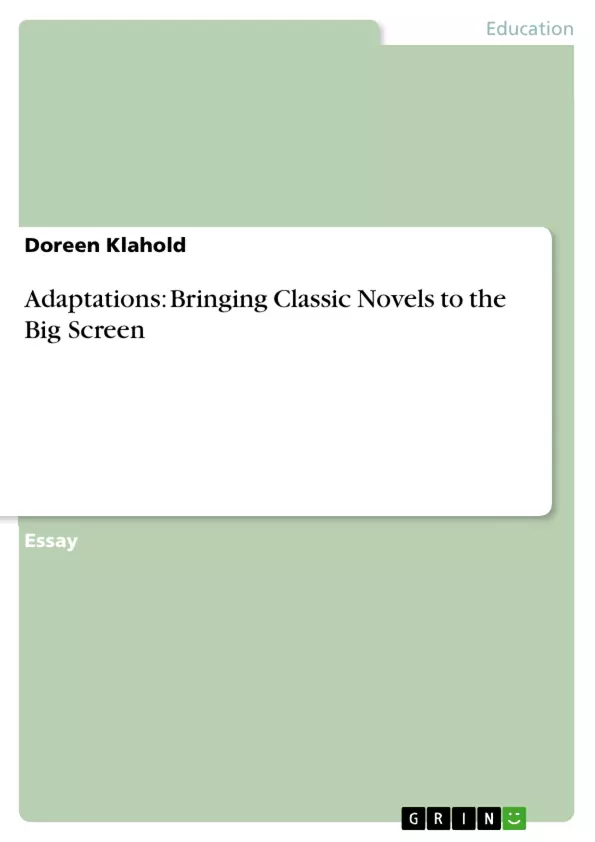Der Essay soll einen allgemeinen Überblick geben, worauf man bei der Adaption von Romanen in Filme achten muss, ohne dabei genauer auf Jane Austen einzugehen. Ich beschäftige mich insbesondere damit, wie narrative Elemente umgesetzt und Stil und Stimmung des Romans beibehalten werden können. Themen meines 4-seitigen Informationspapiers sind die Kürzung der Geschichte, Anpassung narrativer Textstellen, Änderung der Charaktere, Beibehaltung der historischen Distanz und Auswahl der Landschaften, Musik und Kleidung.
Inhaltsverzeichnis (Table of Contents)
- Adaptations: Bringing Classic Novels to the Big Screen
- Cinema and Novel
- Relation between Film and Text
- The Adaptation Process
- Transfer of Narrative Elements
- Character Transformation
- Historical Distance
- Spirit of the Time
- Conclusion
Zielsetzung und Themenschwerpunkte (Objectives and Key Themes)
This paper aims to examine the complexities of adapting classic novels to the big screen, exploring the challenges and creative processes involved in translating a literary work into a cinematic one. It delves into various aspects of adaptation, including the transfer of narrative elements, character transformation, and the representation of historical context.
- Differences between cinematic and linguistic sign systems
- Transforming narrative elements from text to moving images
- Adapting characters for film
- Bridging historical distance between novel and contemporary audience
- Representing the spirit of the time in which the novel is set
Zusammenfassung der Kapitel (Chapter Summaries)
- Chapter 1: This chapter introduces the concept of adapting novels to film, highlighting the differences between the two mediums. It discusses the challenges of conveying abstract concepts visually and emphasizes the need for a creative approach during adaptation. Andrew's three categories of "borrowing, intersection, and fidelity of transformation" are introduced, providing different perspectives on the relationship between film and text.
- Chapter 2: Chapter 2 addresses the issue of adapting a novel's length to the constraints of a film format. It discusses the need to condense the story while preserving its integrity and creating a clear structure for viewers to follow. The importance of cinematic storytelling elements like direction and dimensionality is highlighted.
- Chapter 3: This chapter explores the transformation of narrative elements from text to film. It acknowledges the limitations of visual media in conveying certain aspects of a story, such as mental states. However, it also emphasizes the role of audio-visual elements like voice-overs and dialogue in conveying both narrative and abstract concepts.
- Chapter 4: Chapter 4 focuses on character adaptation, exploring the process of cutting and shaping characters for film. It discusses the need to determine the function of each character within the story and the challenges of adapting a large cast for the screen. The importance of visual characterization through acting and props is highlighted.
- Chapter 5: This chapter examines the significance of historical distance in adaptation, emphasizing the need to bridge the gap between the novel's setting and the contemporary audience. It discusses the use of period pieces and costume dramas, as well as the challenges of achieving authenticity in film settings and costumes. The role of music in creating mood and reinforcing visual imagery is also explored.
Schlüsselwörter (Keywords)
This paper focuses on the adaptation of novels to film, examining key concepts like cinematic sign system, narrative transformation, character adaptation, historical distance, authenticity, and fidelity of transformation. It explores the challenges and creative processes involved in translating literary works to the visual medium, offering insights into the interplay between film and literature.
- Quote paper
- Doreen Klahold (Author), 2010, Adaptations: Bringing Classic Novels to the Big Screen, Munich, GRIN Verlag, https://www.grin.com/document/163918



